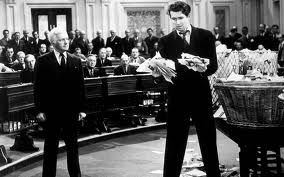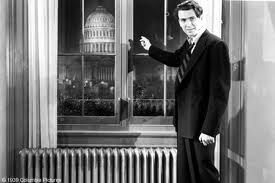 I admit it – I am a romantic. I grew up with my view of the Senate of the United States colored by Frank Capra's tale (and Jimmy Stewart's portrayal) of the trials and tribulation of Jefferson Smith in Mr. Smith Goes to Washington. This holds especially true for my view of the filibuster. Filibusters should look like what Jeff Smith did — one man, standing up in the well of the Senate for what they believe in. But, that hasn't been the case for, at a minimum, the past 4-6 years. As the Brennan Center report on Filibuster Abuse (PDF) demonstrates:
I admit it – I am a romantic. I grew up with my view of the Senate of the United States colored by Frank Capra's tale (and Jimmy Stewart's portrayal) of the trials and tribulation of Jefferson Smith in Mr. Smith Goes to Washington. This holds especially true for my view of the filibuster. Filibusters should look like what Jeff Smith did — one man, standing up in the well of the Senate for what they believe in. But, that hasn't been the case for, at a minimum, the past 4-6 years. As the Brennan Center report on Filibuster Abuse (PDF) demonstrates:
Filibuster Abuse is Rampant: As of October 2012, the current Congress has enacted 196 public laws, the lowest output of any Congress since at least World War II. This is not purely the result of divided party control of chambers. Control of the House and Senate was also divided from 1981 to 1987 and 2001 to 2003. The current Senate passed a record-low 2.8 percent of bills introduced in that chamber, a 66 percent decrease from 2005-2006, and a 90 percent decrease from the high in 1955-1956. Cloture motions — the only way to forcibly end a filibuster — have skyrocketed since 2006, creating a de facto 60-vote requirement for all Senate business. In the last three Congresses, the percentage of Senate floor activity devoted to cloture votes has been more than 50 percent greater than any other time since at least World War II, leaving less time for consideration of substantive measures. On average, it has taken 188 days to confirm a judicial nominee during the current Congress, creating 32 “judicial emergencies,” as designated by the Office of U.S. Courts. Only at the end of the congressional term in 1992 and 2010 have there been more judicial emergencies.
I'm not going to pretend to look at the issue in all its complexity here, but I do wish to look at one aspect of reform efforts that many have fixed upon — the talking filibuster — and contrast that with the proposal towards which, according to Politico , Harry Reid is leaning.
The Talking Filibuster
Under the plan for filibuster reform being offered by Jeff Merkley (D – OR), Tom Udall (D – NM), and Tom Harkin (D – IA), no longer could a Senator simply object to a bill coming to a vote and then it be up to the proponents to file a cloture motion (a motion to limit debate) and then round up 60 Aye votes for that motion. This is how the filibuster has proceeded in recent years. No reading from telephone books, no dramatic soliloquies. This is the “silent filibuster”.
Instead, under the proposal, a Senator objecting to a bill would have to come to the well of the Senate and hold the floor. They could yield the floor to another Senator also opposing the bill, so that the filibuster could go on until cloture is invoked by 60 votes. But, once they surrendered the floor, a simple majority of 51 votes could invoke cloture.
This proposal would retain the tradition of unlimited debate, but, because of the C-SPAN cameras, would actually show the American people that the work of the Senate is being blocked and exactly who is doing the blocking. There is nothing like having video to make a TV news producer salivate. In effect, it would subject the those conducting the obstruction to shaming. This would, in the eyes of the proponents, limit the use of filibuster so that it is no longer the standard that one MUST have 60 votes to accomplish anything.
Shifting the Burden
By contrast, Reid, according to the Politico article cited above, is considering an alternative which would not require the Talking Filibuster. Instead, it would change burden in seeking cloture. Currently, Rule XXII of the Standing Rules of the United States Senate states that debate may be cut off by an “affirmative vote of 3/5 of those Senators duly chosen and sworn”, in other words, 60 Senators.
What Reid is considering as a compromise would instead presume that cloture would be granted unless the opponents of a measure could get the affirmative votes of 41 members to continue debate. This would effectively shift the burden from the proponents of legislation to its opponents. No longer would an absent vote, in effect, count against cloture. The opponents of legislation would have to ensure that their votes actually showed up.
Talking Filibuster vs Shifting the Burden
Since we have already established that I am a romantic in my view of the US Senate (ala Mr. Smith goes to Washington), the idea of the talking filibuster seems to me a good idea. The theory behind the filibuster is that the tradition of the US Senate is one of “unlimited debate”. Well, make those who are making use of that tradition of unlimited debate actually, well, debate. Make them break out the telephone books and read from Moby Dick. No more skulking on the sidelines, obstructing the work of the American people whilst they “dial for dollars” on K Street.
However, as a lawyer, I am enamored of any “compromise” which effectively shifts the burden. When the presumption is shifted against one party (meaning an individual or group, not a political party), they an still make their case, but the other party tends to have the upper hand. Shifting the burden of obtaining votes, in effect, creates a presumption in favor of cloture, as opposed to the current presumption, which favors those against whom cloture is being invoked. There is an elegance to this as a compromise solution. It shifts the terrain while still allowing a determined minority to force compromise.
Of course, these two proposals are not mutually exclusive. Ideally, I would like to see both enacted (together with other reforms, such as making the motions to proceed to legislation, and to hear the report of a conference committee, non-debateable, as well as eliminating the 30 hours of post-cloture time devoted to debate on a nomination). There is no need to choose. However, while both would be preferable, either would be a marked improvement on the current situation. Either way, they do contain a spirit – the spirit of the Capitol Dome.
[poll id=”
117
“]

10 comments